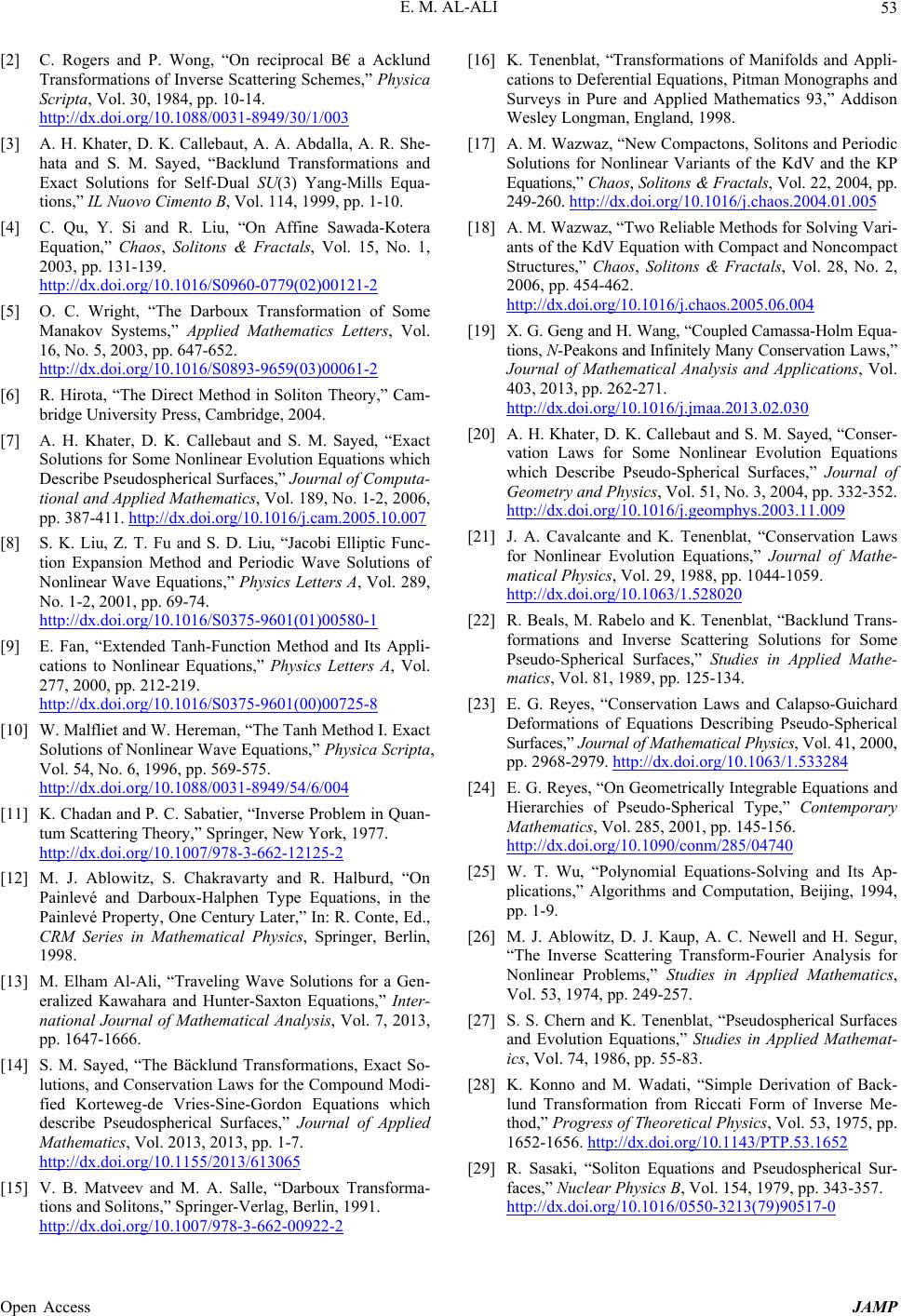
E. M. AL-ALI
Open Access JAMP
53
[2] C. Rogers and P. Wong, “On reciprocal B€ a Acklund
Transformations of Inverse Scattering Schemes,” Physica
Scripta, Vol. 30, 1984, pp. 10-14.
http://dx.doi.org/10.1088/0031-8949/30/1/003
[3] A. H. Khater, D. K. Callebaut, A. A. Abdalla, A. R. She-
hata and S. M. Sayed, “Backlund Transformations and
Exact Solutions for Self-Dual SU(3) Yang-Mills Equa-
tions,” IL Nuovo Cimento B, Vol. 114, 1999, pp. 1-10.
[4] C. Qu, Y. Si and R. Liu, “On Affine Sawada-Kotera
Equation,” Chaos, Solitons & Fractals, Vol. 15, No. 1,
2003, pp. 131-139.
http://dx.doi.org/10.1016/S0960-0779(02)00121-2
[5] O. C. Wright, “The Darboux Transformation of Some
Manakov Systems,” Applied Mathematics Letters, Vol.
16, No. 5, 2003, pp. 647-652.
http://dx.doi.org/10.1016/S0893-9659(03)00061-2
[6] R. Hirota, “The Direct Method in Soliton Theory,” Cam-
bridge University Press, Cambridge, 2004.
[7] A. H. Khater, D. K. Callebaut and S. M. Sayed, “Exact
Solutions for Some Nonlinear Evolution Equations which
Describe Pseudospherical Surfaces,” Journal of Computa-
tional and Applied Mathematics, Vol. 189, No. 1-2, 2006,
pp. 387-411. http://dx.doi.org/10.1016/j.cam.2005.10.007
[8] S. K. Liu, Z. T. Fu and S. D. Liu, “Jacobi Elliptic Func-
tion Expansion Method and Periodic Wave Solutions of
Nonlinear Wave Equations,” Physics Letters A, Vol. 289,
No. 1-2, 2001, pp. 69-74.
http://dx.doi.org/10.1016/S0375-9601(01)00580-1
[9] E. Fan, “Extended Tanh-Function Method and Its Appli-
cations to Nonlinear Equations,” Physics Letters A, Vol
277, 2000, pp. 212-219.
http://dx.doi.org/10.1016/S0375-9601(00)00725-8
.
[10] W. Malfliet and W. Hereman, “The Tanh Method I. Exact
Solutions of Nonlinear Wave Equations,” Physica Scripta,
Vol. 54, No. 6, 1996, pp. 569-575.
http://dx.doi.org/10.1088/0031-8949/54/6/004
K. Chadan and P. C. Sabatier, “Inverse Problem[11] in Quan-
tum Scattering Theory,” Springer, New York, 1977.
http://dx.doi.org/10.1007/978-3-662-12125-2
[12] M. J. Ablowitz, S. Chakravarty and R. Hal
Painlevé and Darboux-Halphen Type Equatio
burd, “On
ns, in the
Painlevé Property, One Century Later,” In: R. Conte, Ed.,
CRM Series in Mathematical Physics, Springer, Berlin,
1998.
M. Elham Al-Ali, “Traveling Wave Solutions for a Ge[13] n-
eralized Kawahara and Hunter-Saxton Equations,” Inter-
national Journal of Mathematical Analysis, Vol. 7, 2013,
pp. 1647-1666.
S. M. Sayed, “The Bäcklund Transformations, Exa[14] ct So-
lutions, and Conservation Laws for the Compound Modi-
fied Korteweg-de Vries-Sine-Gordon Equations which
describe Pseudospherical Surfaces,” Journal of Applied
Mathematics, Vol. 2013, 2013, pp. 1-7.
http://dx.doi.org/10.1155/2013/613065
[15] V. B. Matveev and M. A. Salle, “Darboux Transforma-
tions and Solitons,” Springer-Verlag, Berlin, 1991.
http://dx.doi.org/10.1007/978-3-662-00922-2
[16] K. Tenenblat, “Transformations of Manifolds and Appli-
cations to Deferential Equations, Pitman Monographs and
Surveys in Pure and Applied Mathematics 93,” Addison
Wesley Longman, England, 1998.
[17] A. M. Wazwaz, “New Compactons, Solitons and Periodic
Solutions for Nonlinear Va
Equations,” Chaos, Solitons & Fractals, Vol. 22, 20
riants of the KdV and the KP
04, pp.
249-260. http://dx.doi.org/10.1016/j.chaos.2004.01.005
[18] A. M. Wazwaz, “Two Reliable Methods for Solving Vari-
ants of the KdV Equation with
Structures,” Chaos, Solitons & Fractals, Vol. 28, No.
Compact and Noncompact
2,
2006, pp. 454-462.
http://dx.doi.org/10.1016/j.chaos.2005.06.004
[19] X. G. Geng and H. Wang, “Coupled Ca
tions, N-Peakons and Infinitely Many Conservat
massa-Holm Equa-
ion Laws,”
Journal of Mathematical Analysis and Applications, Vol.
403, 2013, pp. 262-271.
http://dx.doi.org/10.1016/j.jmaa.2013.02.030
[20] A. H. Khater, D. K. Callebaut and S. M. Sayed, “Conser-
vation Laws for Some Nonlinear Evolution Equations
which Describe Pseudo-Spherical Surfaces,” Journal of
Geometry and Physics, Vol. 51, No. 3, 2004, pp. 332-352.
http://dx.doi.org/10.1016/j.geomphys.2003.11.009
[21] J. A. Cavalcante and K. Tenenblat, “Conservation Laws
for Nonlinear Evolution Equations,” Journal of Mathe-
matical Physics, Vol. 29, 1988, pp. 1044-1059.
http://dx.doi.org/10.1063/1.528020
[22] R. Beals, M. Rabelo and K. Tenenblat, “Backlund Trans-
formations and Inverse Scattering Solutions for Some
Pseudo-Spherical Surfaces,” Studies in Applied Mathe-
matics, Vol. 81, 1989, pp. 125-134.
[23] E. G. Reyes, “Conservation Laws and C
Deformations of Equations Describing
alapso-Guichard
Pseudo-Spherical
Surfaces,” Journal of Mathematical Physics, Vol. 41, 2000,
pp. 2968-2979. http://dx.doi.org/10.1063/1.533284
[24] E. G. Reyes, “On Geometrically Integrable Equations and
Hierarchies of Pseudo-Spherical Type,” Contemporary
Mathematics, Vol. 285, 2001, pp. 145-156.
http://dx.doi.org/10.1090/conm/285/04740
[25] W. T. Wu, “Polynomial Equations-Solving and Its Ap-
or
ons,” Studies in Applied Mathemat-
rg/10.1143/PTP.53.1652
plications,” Algorithms and Computation, Beijing, 1994,
pp. 1-9.
[26] M. J. Ablowitz, D. J. Kaup, A. C. Newell and H. Segur,
“The Inverse Scattering Transform-Fourier Analysis f
Nonlinear Problems,” Studies in Applied Mathematics,
Vol. 53, 1974, pp. 249-257.
[27] S. S. Chern and K. Tenenblat, “Pseudospherical Surfaces
and Evolution Equati
ics, Vol. 74, 1986, pp. 55-83.
[28] K. Konno and M. Wadati, “Simple Derivation of Back-
lund Transformation from Riccati Form of Inverse Me-
thod,” Progress of Theoretical Physics, Vol. 53, 1975, pp.
1652-1656. http://dx.doi.o
erical Sur- [29] R. Sasaki, “Soliton Equations and Pseudosph
faces,” Nuc lear Physics B, Vol. 154, 1979, pp. 343-357.
http://dx.doi.org/10.1016/0550-3213(79)90517-0